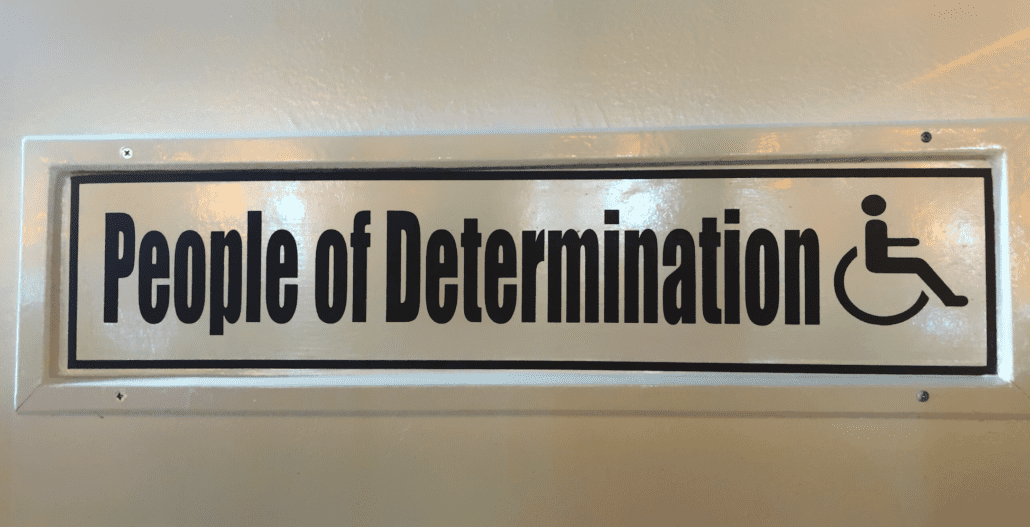 Temporary disability is definitely something that can and does happen to attendees. It could be a sports injury just before leaving for the event. It could be a slip and fall at the airport. It even could happen on site. But whether the disability is temporary or permanent, the person who has it has special needs that need to be accommodated to make it possible to fully participate.
Temporary disability is definitely something that can and does happen to attendees. It could be a sports injury just before leaving for the event. It could be a slip and fall at the airport. It even could happen on site. But whether the disability is temporary or permanent, the person who has it has special needs that need to be accommodated to make it possible to fully participate.
I am learning this fact all too well, up close and personal. I recently shredded the meniscus in my left knee and had to have it surgically repaired — and I am trying hard to learn from the experience rather than just whine about it. Let me say this up front: I am incredibly fortunate to have the means to get this injury fixed and the knowledge that, as much as I really, really dislike being laid up, this too shall pass. So many others do not have that luxury and have to live with their disabilities long term. I totally get that.
But as I was crutching my way around the house the other day, I couldn’t help but feel a much more visceral empathy for those who struggle with disabilities — especially when they have to go on the road to attend a meeting or event. Much e-ink has been spilled, including by yours truly, on how to make events more welcoming and inclusive to those with disabilities of all kinds, but I thought I’d share just a few things from my limited experience of temporary disability that would be worth thinking about when designing your next meeting or event.
Let’s call it notes from Sue’s couch:
Everything takes longer and requires more effort when you have a disability. Just getting ice to put on my knee is a multi-step process that starts with donning my leg brace and entails picking up my crutches from where they lean against the wall, then dropping them, then balancing like a stork on my good leg to pick them up again, then giving up on them and hopping through the kitchen like a drop of water on a hot skillet, leaning against the countertops along the way until I get to the fridge, then standing with an icepack in hand having no idea how to get back to my perch on the couch. Etc., etc. Little things that normally would just take seconds now require minutes — sometimes even hours — to accomplish, if they get done at all.
Relevance to events: We all know how we like to cram the agenda so full that people can’t help but feel they got their money’s worth, and then some. But this not only causes able-bodied attendees to feel exhausted and frustrated — those with physical disabilities literally may not physically be able to dash from general session to meeting room to expo hall to lunch to the networking social even if they wanted to. Give everyone a break and build in lots of transition time, and a lot of breaks to just, well, take a break and soak it all in as well as get to the next session.
You have to have a plan for everything. Before I do anything these days, I first have to think through every step of the process (see #1) and then develop a plan on how to make it work. Even just putting on shoes requires developing a shoe-putting-on system. And to get that box of dog treats off the steps to the garage attic? My carefully thought-out system didn’t work so I had to improvise, hooking the box with one crutch and trying not to wipe out as I tried to catch it while leaning against the wall. Won’t do that again!
Relevance to events: Don’t make your attendees who have disabilities have to develop their own system for navigating your event! Design the aisles to make them wide enough for a wheelchair so they don’t have to way-find a route based on which aisles they can actually get down. Likewise with signage — make it readable and easy to understand and follow. Make sure there are easy ways to navigate between different floors for a multi-level event — no one wants to have to devise a system just to have to get to the next session one floor up when you can’t use the escalator and the elevator is what seems like miles from both your start and end points. And how do you carry a tray of food at the expo lunch area when both hands are occupied with crutches? If I’m still out of action by the time I go to an event, I’m sure there are a million things I can’t think of now that I would have to devise a system to use. It really shouldn’t be that hard — but all too often, it is.
Even seating is hard to figure out sometimes. I have my favorite chair in the space off the kitchen, but there was nothing I could use to elevate my leg. There’s a super comfy chair on the porch for when it’s not too hot — and it even has its own ottoman — but it’s a trek to get to while packing all my stuff. And so forth and so on. Who knew just finding a place to sit would be a challenge?
Relevance to events: Provide seating that’s usable for people of all abilities, including different chairs of heights and widths, some with arms, some without, etc. And don’t put the accessible seating way in the back, or off to the side, or otherwise segregated from where all the good stuff is happening. Nothing makes someone feel more excluded than being siloed off from the action.
It’s hard to accept help, even when it’s honestly and graciously offered. I keep thinking if I just figure out the right system, I can do it all myself — until my physical therapist disabused me of that notion (“No, no one has figured out a good way to go grocery shopping on crutches unless you want to rent a cart,” she told me). Maybe it gets easier over time and experience to accept that, in fact, I can’t do it all myself, no matter how hard I try or how brilliant a workaround I come up with. That means I have to accept offers to help, from cars that stop to let me hobble across the street at a glacial pace to get the mail, to my wonderful spouse who has had to take over everything from grocery shopping to dog walking. But I still find this one really, really hard. What makes it even harder is when help is offered, but you can tell the offer is made grudgingly or with some passive aggressive overtones.
Relevance to events: Train your staff to be willing and able to help — with true good will and empathy. It’s easier than you’d think to tell the difference if someone actually is happy to help versus offering to help but then grumbling under their breath, or rolling their eyes, or saying, “Sure, I’ll do that for you,” then doing 10 other things first to let you know that in fact you’re being a pain for asking them to do something that takes them away from more important tasks, or at least a lower priority than updating the reg system. I know, this is really hard, but it’s a skill that we all should develop whether in a meeting or anywhere else.
I have to rethink emergency situation response with my new, albeit temporary disability in mind. Our smoke detector kept going off this weekend, which was not just ear-shatteringly annoying but also eye opening for someone in my temporarily disabled state. Fortunately, it just needed a new battery, but it made me rethink how I could stay safe if it went off for real. From making sure I have my iPhone not just with me but reachable and charged at all times, to planning a different escape route I could use if I had to crawl out sans crutches, I had to rethink my emergency response systems as well.
Relevance to events: This one’s pretty obvious but be sure to check with your event venue to find out what the plan is to evacuate those with disabilities as well as the able-bodied should an emergency occur. Then test the plan yourself, trying to see it from the perspective of someone who has mobility issues, or a sight deficit, or who may not be able to hear the alarm. Those with disabilities should be at the top of the emergency response priority list, but all too often, they aren’t on the list at all.
I have become the ultimate pack rat. Since I can’t carry anything as I normally would, and making a million trips for everything I need ended up giving me blisters on my hands (darned crutches!), I quickly learned that I needed to carry my essentials with me at all times. So I now have a backpack filled with a water bottle, lip balm, Kindle, iPhone, Kleenex, etc., etc., that I carry around like a giant turtle.
Relevance to events: While your attendees who have disabilities likely are already onto the pack rat thing, make it easy for them — and everyone, really — to find what they need wherever they may be. And if you’re not sure what those essentials may be, ask.
I’m sure there will be a million more learnings as I move (slowly, painfully) through the healing process over the next four to six weeks, which I will be glad to share — just ask! In the meantime, if you are able-bodied, take a moment to feel gratitude for all those things you do every day without thinking about them that, for people with a disability, could be difficult to impossible to accomplish.
And, if it’s not already a part of your due diligence, take another look at every aspect of your meeting design to ensure that it truly is accessible to all, inclusive of all, and welcoming to all. If you aren’t sure, ask someone you know who has a disability, whether temporary or permanent. They likely will come up with things you hadn’t thought of that, once you hear them, couldn’t be more glaringly obvious. All it takes is a little education and a shift in perspective to make small (or large) modifications that will mean everyone — disabled or not — can get the most out of your event. And who doesn’t want that?
You May Also Be Interested In…
New Bill of Rights for Airline Passengers with Disabilities











